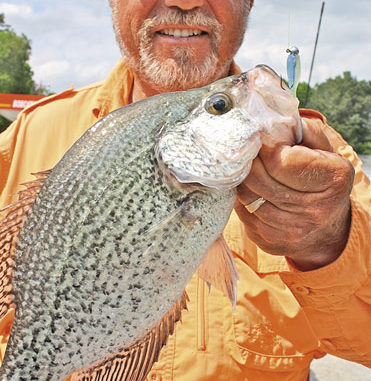
The ‘Fish Doc’ diagnoses ways to consistently catch winter crappie on Kerr Lake.
Keith Wray of Eden — the “Fish Doc” — rarely needs any treatment for cabin fever throughout the winter. The veteran crappie stalker is accustomed to fishing in cold weather at John H. Kerr Reservoir, also known as Buggs Island.
“If the lake isn’t frozen and the ramps are accessible, I’m out fishing,” said Wray, a 58-year-old guide who specializes in casting jigs and trolling for crappie at the huge impoundment straddling the North Carolina-Virginia line.
With almost 40 years of fishing experience on the lake — the last 10 years devoted to crappie fishing — Wray has had time to make a diagnosis and come up with a nearly full-proof prescription for catching slabs almost year-round, including the chilly late fall, winter, and pre-spawn periods.
First of all, Wray cuts the 48,900-acre reservoir down to size by focusing most of his effort on the western and northwestern ends of the lake, mainly because the quickest route from his Eden home puts him at the Longwood Recreation Area ramp off US 15 near Clarksville, Va.
Then, he follows a milk run based upon seasonal patterns and years of experience. As long as the water temperature is above 50 degrees, he fishes up the river from Clarksville to Buffalo Creek. Once it drops below 50 degrees — usually sometime in October or November — he fishes Grassy Creek.
Wray once was an avid bass fisherman, and he still occasionally fishes for largemouths, but he caught a bad case of crappie fever years ago after he witnessed an elderly gentleman paddling a boat about. Using a split-shot rig, the old man was fishing brush he had sunk and catching several huge crappie.
Wray decided to sink his own brushpiles, especially in preparation for winter fishing.
Given typical conditions, Wray said the late fall and winter are the best times for numbers of crappie as the fish stack up in deep brushpiles. The trick is finding productive ones.
Anglers can find them by slowly motoring about with their eyes fixed upon their depthfinders, marking places wherever they locate brush in about 10 feet of water. But on an impoundment the size of Kerr, whose creeks are often larger than some lakes, this quest can be a formidable task, especially in bone-chilling weather.
Fishermen may also opt to plant their own brushpiles, an undertaking Wray has refined to get the biggest return.
Wray said anglers must realize that not every planted brushpile will yield fish. If one brushpile out of five gives up fish, that’s a good return. Occasionally, anglers will strike a crappie bonanza.
“I’ve caught 150 crappie from one of my brushpiles,” Wray said. “I also have four brushpiles that have yet to produce a fish.”
Wray’s contact with other crappie fishermen makes him privy to the whereabouts of brushpiles sunk by others.
Wray said the first time a fisherman sweetens a place with brush, he should use a willow.
“Willows attract fish better than other brush, but they fall apart within a year or two and must be replaced,” he said.
If a willow pile holds fish, Wray replenishes it with brush from hardwoods such as maple or water oak.
To get the best results, brushpiles should be planted on steep drops, the edges of deep flats or points, and other irregular features along the lake bottom.
To hold fish year-round, Wray said a brushpile should be sunk 20 to 25 deep so that its highest point will rest about 10 feet beneath the surface.
“The water level at Buggs is constantly fluctuating; the brush should be deep enough that it won’t be left high and dry with low-water levels, but not so deep that it becomes hard to fish with high-water levels,” Wray said. “The brush should not be placed where it might become a navigational hazard.”
Before sinking any brush, fishermen must receive a permit from the U.S. Corps of Engineers or be subject to a $500 fine.
Sinking brush may not be a practical matter for fishermen who live at a distance from Kerr. It’s also tedious labor.
One rule is not to place brush at a place that is already giving up numerous crappie.
A final option for fishermen unacquainted with the lake is to fish in the company of a local fisherman who can “show you the ropes” or hire a guide who can put you at the door step of brush houses where the crappie reside.
To catch crappie from sunken brush, Wray employs either casting or tight-lining. The latter equates to slow-trolling. When casting, he uses a countdown method whereby his cadence indicates the depth he’s fishing. When tight-lining, his rate of speed dictates the depth he’s fishing. Speed and depth are critical when tight-lining to prevent snagging the baits in the brush.
These tactics are used when the fish are holding tight to cover and sluggish because of cold water.
His favorite baits include 1/16th-ounce Lindy Fuzzy Tail grubs and Charles Brewer Slider grubs, sometimes tipped with minnows.
With lake temperatures warming into the 50s by late February sparking more aggressive prespawn fish, Wray resorts to flat-lining, which is essentially fast-trolling.
“I have better luck catching bigger crappie when I’m flat-lining,” said Wray, who does most of his winter and pre-spawn fishing within the creeks in five to 10 feet of water.
Wray’s boat may be in deeper water than 10 feet, but he focuses upon 5- to 10- foot depths in the water column for suspended crappie. With warmer temperatures, the fish could be in five feet of water or less.
Wray said Kerr holds white and black crappie, with the typical fish measuring 10 inches.
“Any fish weighing more than two pounds is a big crappie at Kerr,” he said. “A 3-pound crappie is a rarity.”
Wray’s best haul came last March on one outing when he had caught four crappie topping the 2-pound mark. His biggest fish, a 3-pound, 12-ounce black crappie, was caught with a jig in August.
As a general rule for winter fishing, when water temperatures range in the 30s and 40s, those temperatures translate into sluggish, suspended fish that are largely inactive and extremely difficult to catch. With these temperatures, fishermen would be better served to tinker with their tackle at home.
When the water temperature rises into the upper 40s, the fish make some half-hearted, preliminary movements to the shallows, but the return of cold weather quickly pushes the fish deep again. Once water temperatures exceed 50 degrees because of warmer days and more prolonged periods of sunshine, the fish migrate to the shallows in earnest, where they stack up within the creeks. That’s the time to be on the water.
Besides water temperature, Wray said water level also affects crappie fishing — for better or worse.
“If the lake is high with the water moving into the woods, the fish are scattered and hard to find because there’s so much available cover,” he said. “When the lake drops, the fish pull out to deeper, less plentiful cover. Local fishermen know where to find the deep cover.
“The best water level for crappie fishing is the 296-foot mark. At that level (five feet below normal pool), the water is out of the woods and bushes.”
If fishermen follow Wray’s guidelines for catching crappie, the time between bites should grow shorter.

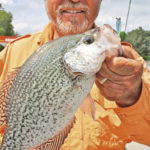
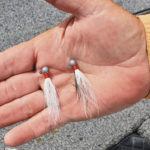
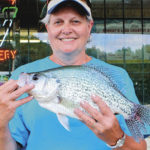
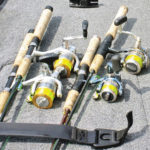
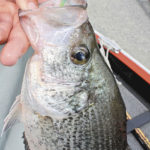
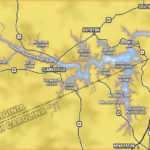


Be the first to comment